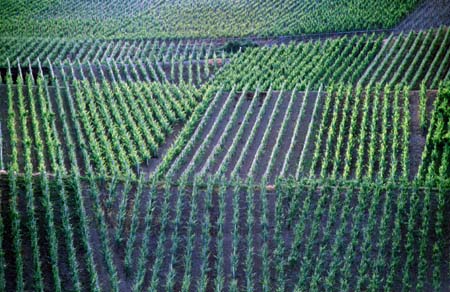The Ahr is one of Europe 's
northernmost wine regions. It is also the smallest in Germany , with vineyards
extending only 25 km along the Ahr River as it flows toward the Rhine just
south of Bonn . From Altenahr, in the west, to the spa Bad Neuenahr, the vines
are perched on steep, terraced cliffs of volcanic slate. In the eastern end of
the valley, the slopes are gentler and the soils are rich in loess. The vines
are at the mercy of spring frosts and would not ripen at all so for north
without the step slopes to protect and help with ripening with maximum sun
exposure. The red grape vines were brought here from Burgundy at the end of the
seventeenth century, the Pinot noir grape which is here called the
Spätburgunder or late Burgundy accounts for over 50% of the area .Today four
out of every five bottles of Ahr wine are red wine, the Spatburgunder wines are
velvety to fiery and wines made from the Portugieser are light and charming.
There are plantings of Dornfelder which is on the up and up. and there are small
pockets of the steely fresh Riesling and Muller-Thurgau. Since the 3rd century
AD wine is cultivated at the Ahr. First of all the Romans established the
cultivation. This is verified by the excavation of a vineyard in 4 m depth.
Wine-growing is for the first time verified by documents in the year 770. Since
the 17th century the Ahr is known as a red wine area.
In 2003 the region of Ahr which has
525ha under vine produced 40.793 hectolitres of grape must which gives a yield
of 80,9 hectolitres per hectares this was split into 0,0% table wine 26,3% QbA
wine and 73,7% QmP wines.
Geographical location: On both sides
along the Ahr river.
From Mariental on a length of 25 km,
to the mouth into the Rhine river near Linz .
The Ahr Valley is on the fringe of
the protective Eiffel Hills.
Major town(s): Bad
Neuenahr-Ahrweiler.
Geology:
Deep, rich loess soils in the lower
Ahr Valley with slate, volcanic stone and rocky soils in the middle Ahr Valley
.
The region is located in the Rhenish
slate mountains. Clay, devon and quartzite slate are often found as primary
rock. Especially in the lower Ahr valley partially with loess and loess-clay
coating. This special condition of the soil results in a "hot-water
bottle" effect. The soil accumulates the sun irradiation during the day
and emits the warmth again at night
Climate:
The climate is quite mild and
favourable for vine growth with some greenhouse-like temperatures on some of
the steeper sites. The steep slopes also help with frost protection as the cold
air falls down to the river valley bottom. The steep valley clefts protect the
Ahr valley from cold winds. Full-bodied red wines can develop on the steep
southern slopes despite the northern location of the region. The river
partially reflects the sun irradiation to the vineyards. But there is still the
danger of late and early frosts.

